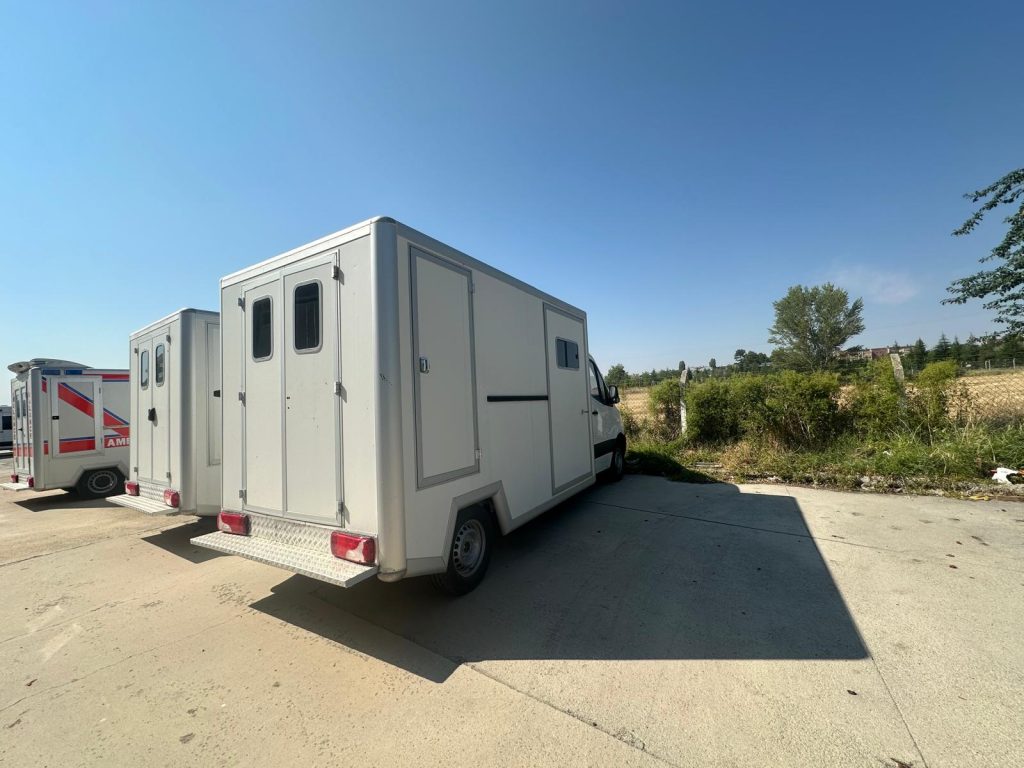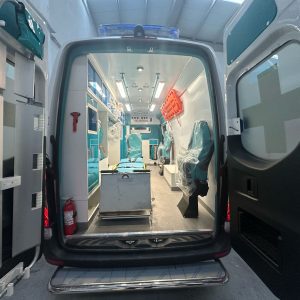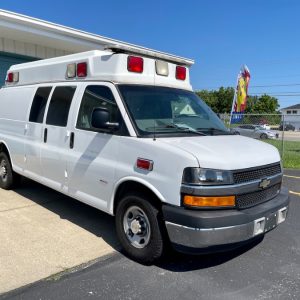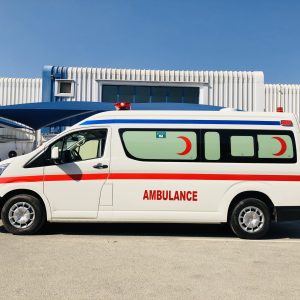1. Introduction to Ambulances
Type 1 Ambulance; Ambulances play a crucial role within the lifecycle of healthcare, particularly in the setting of emergency medical services. Historically, ambulances started off as basic transportation vehicles, aiding in the transport of patients. Over the years, the role of the ambulance has evolved from being a mode of transportation to an actively functioning entity that serves as the first point of contact when it comes to specific healthcare diseases or illnesses. Today’s ambulances are equipped with advanced medical supplies and technology to accommodate almost every type of illness or injury a patient is suffering from. Regulatory standards and guidelines are set in place to ensure that ambulances operate in ways that optimize patient safety by providing evidence-based quality care. Emergency medical service providers are strategically placed in communities and have a response time set to provide rapid care and transport to patients in need. Quick access to new medical treatments available to patients in the pre-hospital setting has the potential to significantly improve patient outcomes for many medical conditions. There are two overarching groups of ambulance services: emergency medical services and non-emergency medical services. In many countries, ambulance services can be government-operated or privatized.
Ambulance services have various stakeholders partaking in the operation. This includes the CEO or managing director, a medical director, other administrators, ambulance director, support staff, paramedics, emergency medical technicians, volunteer staff, and others such as first responders, dispatchers, and education and training staff. Ambulances are universally recognized as a pop-up clinic that is capable of treating people in emergency conditions. An ambulance is an important aspect of the healthcare industry and the first point of medical contact during times of medical emergencies. People facing life-threatening injuries can seek medical help from ambulance facilities, or in the event of accidents, people can be transported from one location to a hospital for first aid. Modern ambulance types include volunteers, groups of firefighters, and air ambulance services. Mobile hospitals and the use of an ambulance as an emergency room have become much more prevalent since the beginning of mass social welfare initiatives. It is also understood as an urgent medical care environment located outside of the hospital. Each of these general types of ambulances has been further specialized to maintain current patient needs.
2. Basic Types of Ambulances
The basic types of ambulances have distinct purposes, leading to differences in design. Broadly, types of ambulances are divided into Type 1 Ambulance, II, and III. Type 1 Ambulance, also known as a truck ambulance, modular ambulance, or box ambulance, typically have modular designs and offer adequate interior space to move about the patient or provide medical interventions while in transport. These types of ambulances feature custom-tailored designs, and they often support a gross vehicle weight of between 9,500 and 14,000 pounds, which can accommodate additional equipment for treating and managing patients en route. Type 1 Ambulance are often utilized for transporting patients with one or two emergency medical technicians in the patient compartment or a paramedic, and one to two EMTs in addition to the driver. Due to the large patient compartment, ambulance attendants are not required to use jump seats for EMS transport in Type 1 Ambulance, and, as a result, these vehicles are often used to provide advanced life support care to patients.
Type II ambulances, also known as a van ambulance, generally comprise supplemental vehicles meant for transporting patients. They are not usually used for providing medical interventions during transport. A Type II vehicle often offers a push-button door to facilitate loading during standing operations, and it features a customizable ambulance design. Moreover, Type II ambulances typically support a gross vehicle weight ranging from 5,600 to 8,500 pounds and are used to transport patients, often with a single EMT in the back and a driver trained to provide basic life support care. Type III ambulances, often referred to as a cutaway ambulance, usually sport box-type patient compartments and front cab or cab-overs, making a cohesive van-like ambulance. They provide room for sole or additional EMTs. Type III ambulances are flexible enough to offer advanced life support and basic life support care on the move.
2.1. 1. Type 1 I Ambulances
Type 1 Ambulance, as a whole, are of modular design, meaning the back portion of the ambulance is a module separate from the chassis that contains the cab for the driver and attendant. The all-modular configuration allows for easy access to the patient care area and more room inside for the patient, equipment, and responders. These ambulances will carry a basic to advanced life support medical crew. Type 1 Ambulance are produced in large numbers in order to serve as emergency response vehicles for large cities, suburban, and rural communities that have specialized vehicle requirements, such as four-wheel drive, high ground clearance, and off-road capabilities. These vehicles are constructed on van-sized to medium-duty truck-based platforms with passenger and driver access from a forward door, such as a typical pickup truck or a full-sized van, and with no access between the driver and patient compartment.
The Type I ambulance is the perfect ambulance for long-distance rural 911 services where the patient requires a critical care nurse, respiratory therapy technician, or specialist to ride along with the crew, along with a full complement of monitoring equipment that wouldn’t fit or be appropriate on a smaller ambulance. The Type I chassis can also withstand the additional weight of larger equipment, such as a defibrillator, that the smaller chassis could not handle. With proper maintenance, this model also has the capability of a long life cycle compared to the smaller Type II ambulance. Often, a Type II and Type III are added to the fleet with 911 services so that a Basic Life Support unit can respond during the same dispatch, should a patient need two emergency ambulances. In rural areas, an ALS unit might have safer road or winter weather access than a city-style Type II ambulance.
2.2. 2. Type 2 II Ambulances
Type II ambulances are commonly used for non-emergency medical transportation, such as transferring patients from care centers during the day for scheduled appointments and then taking them back. They are efficient, convenient, and accessible. If comfort and easy patient transportation are a concern for a facility, then a Type II ambulance is probably what they will go with. In the healthcare facility management field, if the facility is located in an urban area or a neighborhood that has built up over the years, then most likely when they transfer patients, they will need to use a Type II ambulance because Type III and Type 1 Ambulance must be on flat surfaces in order to lower the cot into it. Although many facilities have found that it might be cheaper to go with a Type III because it might last longer, they still choose to use a Type II because it is convenient for the patients.
One would prefer to use these types of ambulances if certain criteria are met. For example, if there is a main health facility that another smaller facility is transferring patients to and from often, it would be useful for them to have one that helps transfer patients for a doctor’s appointment or any other elective service. Most patients do not want to be outside because it would be cold during the winter or too hot during the summer. Manufacturers who meet the requirements of the standard build Type II ambulances. Their interior layout is all about easily transferring patients from one point to the next and is equipped with an ambulance cot. In some models, the rear entry door is painted and decaled, and lighting is installed both inside and outside the vehicle to ensure that the rear interior is illuminated when the door is open. They usually do not have an attendant’s seat stationed for working with patient care because patients are seated when care is performed on them.
2.3. 3. Type 3 III Ambulances
Part 2: Description of Ambulance Types
3. Type III ambulances Type III ambulances are also designed for the highest level of care – critical care transport (CCT) – that falls under the realm of advanced life support (ALS). Again, the Type III models are often used as 911 urgent response vehicles, too. They are sometimes referred to as a “cutaway” because they use the rear of a van or truck cab as the ambulance module. Most Type III ambulances are on a box chassis and some are on an extended cab chassis. These variations in length assure that the vehicle has sufficient space for a crew to stand up while the patient care area is constructed or, if we’re lucky, a patient can be assessed and treated during transit. The patient compartment and the cab are basically one room.
Most commonly, the medical equipment storage cabinetry extends the length of one side of the ambulance, from the front of the patient care area all the way to the back. The action area at the junction of the patient and decontamination/collision area can be quite substantial. This helps assure that necessary patient care equipment is immediately accessible. In some cases, additional equipment cabinetry or other styles of pouches hanging from the ceiling line toward the outside of the vehicle provide additional storage. All of these special features are chosen by the contractor according to the population needs and how the local EMS jurisdiction administers the provision of emergency care to the local citizens, and how they transport patients. In many urban and metropolitan areas, Type III trucks are most common. Other common names for Type III ambulances include vanbulance and van/wagonette. If the chassis is an extended cab, it is often called a life liner, such as a Type III life liner. These ambulances are typically used in urban or metro areas. They excel in tight parking spaces and maneuvering through city traffic. The patient area is accessed from the front seats through a walk-through area or a special door that is between the cab and the patient area. They enable quick personnel access to the patient during transport. In the past 20 years, there has been an increase in the sheer volume of Type III units owned and operated by an increasing number of agencies and contractors. Some of them can have the same technology, safety, and patient/staff comfort features found in the Type I truck designs. A few uniquely designed Type III emergency vehicles have redefined the concept of safe patient delivery and transport.
3. Specialized Ambulance Units
Ambulance services must be highly versatile to meet the complex health needs of the community across a large range of circumstances. This has led to the development of ambulances designed to meet very specific needs. Specialized ambulance units help improve service delivery to diverse populations with very different requirements, especially regarding neonatal and bariatric populations.
Neonatal units are small ambulances that are designed to gently and comfortably convey a specifically trained baby lying prone to a neonatal intensive care unit. Much of the equipment in these vehicles has been specifically engineered to provide the most secure and comfortable transport available. These vehicles are usually designed to transfer babies with chronic illnesses, premature infants, or babies requiring surgery.
Ambulances designated to convey bariatric patients have been gradually added to some ambulance services over the last 10 years. Bariatric ambulances boast a much larger patient capacity, as well as increases in weight tolerance and stability features. They are staffed with a minimum of three paramedics, with at least two holding formal training in advanced airway management, along with neonatal training. The assessment of the patient starts as soon as the patient is identified and continues through assessment and treatment. Staff receive training in arduous patient handling and emergency patient retrieval to ensure safe patient retrieval and transportation. All operational and clinical staff in both fixed and rotary wing air ambulance organizations operate as team members and have undergone training in this aspect.
3.1. 1. Neonatal Ambulances
Neonatal transport is different from adult transport and child transport. Neonates’ biochemistry, physiology, body temperature, and other functions are in a continuous dynamic process of development, differentiation, and interaction, especially the strong regulation of the senses. Our needs lead to a particularly weak self-regulation of neonates facing the impact of external environments and stress. Therefore, custom-designed life-support systems are needed to cater to this. Babies who need transport are more likely to die than others of the same disease. Trauma is one of the main reasons. This means that safety is more important than anything else. In addition, the neonate has a quite strong temperature tolerance a few days after birth, and during this time, it is necessary to maintain the baby’s body temperature to a large extent above 36°C to maintain the baby’s “thermal neutral zone.” Failure to do so can result in hypoglycemia, acidosis, and even organ failure. Thus, maintaining body temperature in newborns is extremely essential during transport. Moreover, frequent and effective observation is also required. The operating procedures and team quality required for neonatal transport vehicles should be the same as those for the field. Clinical experience tells us that the transfer of small patients is more difficult than the admission of small patients to the hospital. It is especially risky for the most critically ill patients. Highly specialized transport teams should include at least one nurse certified in neonatal intensive care and a team of two to three experienced members. Currently, there are two technical systems for the transport of critically ill newborns: treatment on the way and tend on the way. Basic medical equipment used for transport includes baby care stations, incubators, monitoring equipment, infusion facilities, oxygen cylinders, and mechanical ventilation equipment. Neonatal intensive care personnel can provide preventive cooling therapy for HIE, and the treatment time is 72 hours. Neonatal transport vehicles must have a cooling time of at least 3 hours to safely transport babies to the regional neonatal intensive care center while maintaining the necessary low temperature constant. The design of neonatal ambulances should follow the ergonomic and humanization principles of special cart design. The ergonomic ambulance emphasizes the coordination of large internal space and small vehicle dimensions, emphasizing the comfort and safety of the patient during transportation, and ensuring the convenience and advantages of ambulance personnel in the internal transport process.
3.2. 2. Bariatric Ambulances
3.2.1 Bariatric Ambulances
A bariatric ambulance is designed to accommodate larger patients safely and in comfort. Supporting this aim, the main components of bariatric ambulances are the same as those in conventional ambulances: all four sides have doors allowing easy access in and out of the patient care compartment. However, the actual inside of the bariatric ambulance is quite different. Bariatric ambulances have steel or aluminum bar and post supports underriding the patient care compartment to provide structural counterbalance. The vehicle platform is also reinforced to distribute the additional weight of the bariatric-designed patient care compartment. This is done to assure that bariatric patients will not compromise the ambulance structure. The patient care portion of a bariatric ambulance is considered modular because it has been designed and installed as one piece by a manufacturer, which is not necessarily the same manufacturer as the chassis of the ambulance.
Vehicle lift systems are used to bring patients into the ambulance. The majority of the vans of these ambulances are fitted with a 1,000-pound capacity, electrically operated, internal/external, collapsible vehicle lift gate. The width of these lifts is 37-38 inches when installed in their normal operating position, which is sufficient for bariatric stretchers to fit through. An LPG-powered vacuum is installed in the vans’ onboard air system. Bariatric ambulance vans have also been equipped with one 20-inch frame port, one interior cabinet port, and one exterior forced air ventilation port, and forced air ventilation to the rear of the bariatric module. A four-port vacuum system capitalizes on air from the interior of the bariatric ambulance van. General Information: Two E450 Bariatric Ambulances were purchased in August 2018. The two units are the first bariatric ambulances housed on the west side of the county. All ambulance crews have been trained to operate and can provide care for bariatric patients. More than one 911 unit crew member has been trained in bariatric operations. All 911 shifts have been trained in bariatric operations. Bariatric equipment and supplies are carried by all 911 units.
4. Ambulance Equipment and Features – Type 1 Ambulance
The use of advanced medical technology in an ambulance can drastically impact patient care and their ultimate outcome. The most important piece of hardware in any ambulance should be the stretcher, which serves as a required piece of equipment due to its use during vehicle transport. It helps emergency and healthcare professionals move stricken patients or accident victims, is utilized as a surgical table, and can be nested with other equipment like ventilator boxes and other specialized medical gear. The removal vehicle should have lift features and a sliding, self-contained ramp that enables one person to safely load and unload the victim to and from the ambulance. The safety of an immobilized or unresponsive patient should be considered during the design and dimensions of the vehicle’s passageway. Defibrillators, emergency medical kits and medications, body splints, head and neck immobilization devices, and oxygen therapy equipment are standard equipment in most ambulances and are frequently mounted on an interior wall. The inside setting is frequently tidy and well-organized, allowing for easy access to all equipment and supplies. The Universal Standard Ambulance has the advantage of ensuring that any piece of equipment or a piece of life support equipment on one ambulance can be directly transported to a different ambulance with the same design without alteration. Extra equipment and technology can be loaded on an ambulance.
A safety alarm and control in the passenger compartment and driver cabin allows crew members to communicate during vehicle operation. Mattresses with practical and hygienic covers are included in the price. An articulating chair with a safety harness can be installed to secure the patient during a difficult team operation. In most locations, new emergency ambulances must conform to ambulance design standards, as well as meet the technical specifications set out in the latest version of Federal Ambulance Standards. Each state or territory must additionally establish requirements for the inspection, care, and cleaning of ambulances per the Hygiene Code. An ambulance that can accommodate a sitting, standing, or reclining patient, a stretcher, one or two additional caregivers, and several different pieces of life support equipment for monitoring patients’ vital signs, performing basic and advanced airway management, cardiac life support, and normal saline fluid resuscitation is the most common configuration in the United States. Specialized interior features can be requested on an as-needed basis. An ambulance specifically designed to accommodate a critical care patient during transport is known as an “intensive care ambulance.” It is frequently staffed by a registered nurse and is capable of providing advanced life support, including treatments that may be unavailable in the most common type of ambulance. The defibrillator for advanced cardiac life support and a monitor/defibrillator, multi-function monitoring devices, carry a vast selection of oral and IV medications, injectable medication and fluids for resuscitation, and blood. While identical in appearance, non-emergency ambulances are detailed by the identification markings and decals on the exterior of the vehicle. Some regions refer to it as a “patient transport vehicle” and usually do not provide emergency treatments, instead relying on a basic life support system like first aid volunteers. Some have developed more advanced procedure allocation models; frequently, non-emergency ambulances use premium ambulances for sick patients rather than emergency cases but still provide care during long-distance interfacility transfers. Some vehicles also function as vehicles for mortuary transport.
5. Future Trends in Ambulance Design – Type 1 Ambulance
Type 1 Ambulance is rapidly evolving, and new ambulance concepts are being considered around the world. Ensuring optimal patient care during transport is a major focus of new designs. At higher levels of care, telemedicine solutions and video conferencing are incorporated to extend the clinical expertise of the attendant team to tertiary care centers in real-time. Custom robotic arms would allow for distant physical exams and even remote control of medical equipment by the consulting ‘expert.’ Enhanced vehicle automation prevents the patient from feeling every turn or having dramatic acceleration or deceleration events. The incorporation of these conveniences should improve patient satisfaction and care, enhance teamwork between providers including first responders at the scene, and aid in providing care to a patient’s support persons prior to arrival at the hospital. As with all vehicles, ambulance manufacturers have taken strides to make their vehicles more sustainable. Weight, fuel consumption, and emissions can all be decreased with better design. These features can now be seen in engines, powertrain options, and alternative fuel sources. In addition, manufacturing plants are increasing their usage of recycled materials and sustainable resources for the production of new vehicles. Another trend in vehicle design is patient-centric features. Patient comfort and patient movement are taken into account. In some vehicles, the need for a large pass-through between the cabin and the rear compartment has been eliminated, making it easier to keep the back of the ambulance warm in the winter months and cool in the summer. Combining new paint and material technologies to fight off infection; fluid-proof, easy-to-clean wall and ceiling surfaces; and designs to increase reliability and ultimately vehicle lifespans are all integrated into future ambulance options. Future ambulances may even be run on autonomous vehicle operations. Emphasis is made on enhancing connected intelligent systems at the ambulance intake hospitals and fleet operations to completely eliminate the dispatch element of referral link requests internally only by referring patients to the best available facility based on patient needs first, then facility capability. The quality of care and acute needs of the patient and thus their requirements at a facility remain the same and are addressed by the elected delegate or council. The functions of the call centers would, in the best scenarios, be designed to aid in a hospital response preparedness by issuing various dispatch commands for specialized units or agency partners such as hospital support, environmental help, and community-based collaborators.













